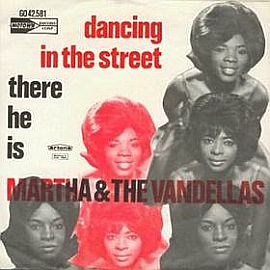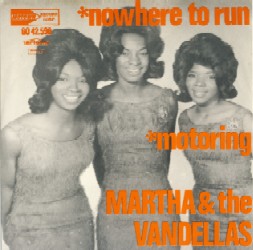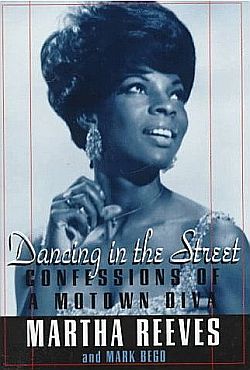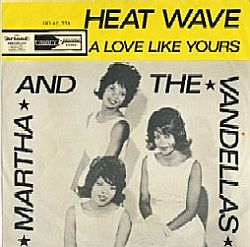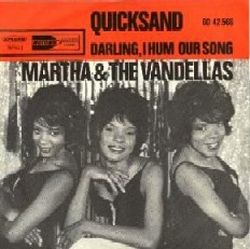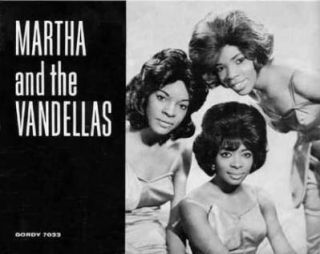
Martha & the Vandellas on 1964 record sleeve, from left: Martha Reeves, Annette Beard & Rosalind Ashford. Click for 'Best of' CD.
The Martha and the Vandellas sound was distinctive, and it would become one of the hallmark musical identities associated with Motown for years thereafter.
In the 1960s, this music also distinguished Motown as a rising music power. For at that time, Motown was just beginning to be noticed at the national level.
Heat Wave’s Hope
One of the first big hits to come from Martha and the Vandellas was “Heat Wave”– a key song released in July 1963; a song that helped send this group, Motown, and its songwriters into the realm of big business. At the time, leading-edge baby boomers, with their significant buying power, were moving through their high school years. “Heat Wave” hit the streets precisely as millions of these kids were coming of age.
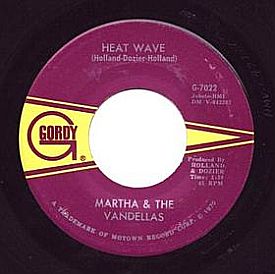
A 45 rpm of Martha & The Vandellas’ ‘Heat Wave’ on the Gordy label from Motown, 1963. Click for digital.
Music Player
“Heat Wave” – 1963
The song’s full title is actually “(Love is Like a) Heat Wave,” with lyrics about teen love describing a young girl’s heart burning with desire — “like a heat wave.” As Martha and her ladies ask: “Has high blood pressure got a hold on me, or is this the way love’s supposed to be?” Their answer: “Can’t explain it, don’t understand it, ain’t never felt like this before.” But in 1963, the power of this song was not in its lyrics. Rather, this tune aroused its listeners with buoyant hand-clapping, an unyielding drum beat, and pure musical drive. Its “message” was its energy and its vibrancy. “Heat Wave” offered its coming-of-age charges pure possibility. To them, the song’s optimistic musical assessment suggested wide-open horizons with few limitations. Indeed, the times were more innocent and full of hope — those halcyon days of September 1963, prior to JFK’s assassination.
Million Seller
“Heat Wave” became a million seller, and by late September 1963 it had risen to No. 4 on the pop charts and No. 1 on the R&B charts, remaining in those spots for about five weeks. “Heat Wave” was produced by a famous three-person team at Motown — a team consisting of the two brothers, Brian and Edward Holland, along with Lamont Dozier. This talented trio — “Holland-Dozier-Holland” as they came to be known, or HDH — wrote and arranged a number of Motown’s top songs, producing a distinctive sound that helped define American popular music in the 1960s.
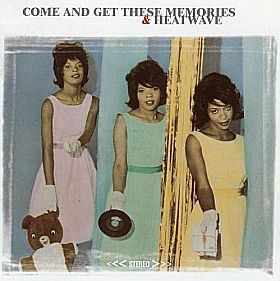
Cover of a 2009 U.K. remastered CD with 'Come & Get These Memories' & 'Heat Wave,' plus four bonus tracks. Universal/Island. Click for CD.
“Heat Wave” was the second collaborative hit between the Vandellas and HDH. “Come and Get These Memories” had been Martha & the Vandellas’ first hit, released earlier in February 1963. “Memories” rose to No. 29 on the Billboard singles chart, and No. 6 Billboard R&B chart. But it was “Heat Wave’s” success that helped propel the “Vandellas-HDH-Motown” sound to new heights. The song also garnered the group’s only Grammy Award nomination — Best R&B Vocal Performance by a Duo or Group for 1964. “Heat Wave” was followed shortly by another song in the same vein, as HDH turned out “Quicksand,” released in October 1963.
“Quicksand,” like “Heat Wave,” was another very “danceable” tune. In its lyrics, the lover this time was bringing his lady “closer and closer” — into a love that was like “quicksand,” causing her to fall “deeper and deeper in love” with him. This tune rose quickly on the charts, reaching No. 8. It was the third hit for the Vandellas and the HDH team.
|
Getting Their Start
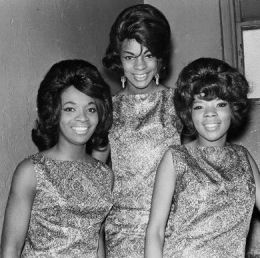 1960s photo of Martha & The Vandellas – from left: Annette Beard, Martha Reeves, and Rosalind Ashford at the Apollo Theater in Harlem. |
“Dancing in the Street”
In July 1964, came perhaps the crowning gem of Martha & The Vandellas’ career — “Dancing in the Street” — another signature Motown tune and one of the Vandellas’ most famous songs from that era. This song was produced by William “Mickey” Stevenson and written by Stevenson and soon-to-become Motown star in his own right, Marvin Gaye.
Music Player
“Dancing in the Street”-1964
Originally written with another singer in mind, Kim Weston, Martha and the Vandellas did the song after Weston passed on it. When Martha Reeves first heard the demo, she asked if she could arrange her own vocals to fit the song’s message. Gaye and Stevenson agreed. They also included a new Motown songwriter, Ivy Jo Hunter, who helped with instrumentation and musical composition. The song was then recorded in two takes.
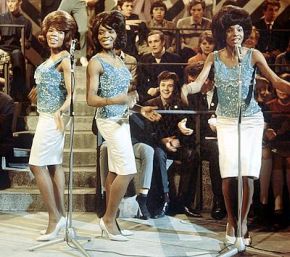
Martha & the Vandellas performing, 1960s.
Calling out around the world,
“Are you ready for a brand new beat?”
Summer’s here and the time is right
For dancing in the street
They’re dancing in Chicago
Down in New Orleans
In New York City…
All we need is music, sweet music
There’ll be music everywhere…
“Dancing in the Street” was released in late July 1964 and played through that summer at the height of the civil rights movement in the U.S. Some interpreted the song as a call to “demonstrate in the streets,” others as an anthem for social change. However, Martha Reeves would remark at one point that it was nothing more than “a party song.” And according to co-writer William “Mickey” Stevenson, the song was inspired by the sight of a group of multi-racial kids playing in the spray of a fire hydrant on hot summer evening in Detroit in the summer of 1964: “All the hatred and prejudice in the world, and these kids had no concept of it,” Stevenson would say. And notably, Berry Gordy had fashioned his Motown music business for commercial success with the idea of his stars “crossing over” to appeal to larger white audiences all across the country. So “Dancing in the Street” was not designed as music to incite street riots.
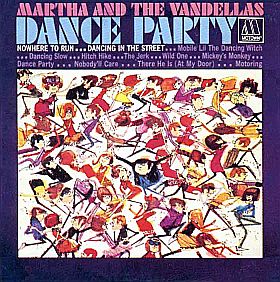
Martha & the Vandellas ‘Dance Party” album of 1965 included ‘Dancing in the Street’ and other of their popular songs, and is regarded by some as one of their best compilations. Click for CD.
Motown recording artist Marvin Gaye would later observe that of all the Motown acts he’d recalled from the 1960s, “Martha & The Vandellas came closest to nearly saying something [political].”
Gaye added: “It wasn’t a nearly conscious thing, but when they sang ‘Quicksand’ or ‘Wild One’ or ‘Nowhere To Run’ or ‘Dancing In the Street’, they captured a spirit that felt political to me. I like that.” Still, for many, it was just good music.
It does appear, however, that by 1967 something of a turning point had occurred, as Martha and the Vandellas and other Motown artists toured the country during a time of racial strife and urban unrest. “Dancing in the Street” and other Motown songs became more politically freighted than they had been, whether intended or not.“Dancing in the Street” and other Motown songs became more politically freighted than they had been, whether intended or not. In fact, politics and pop music from that time on became more intertwined at Motown and elsewhere. At least some of the music at Motown and other labels — as well as the artists themselves at those labels — began addressing civil rights and other national issues more directly than had occurred previously.
In more recent years, books such as Dancing in the Streets: Motown and the Cultural Politics of Detroit (2000, Harvard University Press) by Suzanne Smith, and Ready For a Brand New Beat: How “Dancing in the Street” Became the Anthem for a Changing America (2013, Riverhead) by Mark Kurlansky, have probed the historical and cultural impact of Motown’s music and business on both Detroit and the broader civil rights movement. In addition, recent magazine articles, including Rollo Romig’s New Yorker piece of July 2013, “‘Dancing in the Street’: Detroit’s Radical Anthem,” and another that same month at Slate.com, adapting a piece from Kurlansky’s book, are also worth exploring.
“Dancing in the Street,” in any case, was a huge hit in the mid-1960s, and remains a classic of the period. Tom Moon, writing in his book, 1,000 Recordings to Hear Before You Die, labels it the “Quintessential Summer Single.” In November 2005, the song was ranked No. 40 by Rolling Stone’s list of “The 500 Greatest Songs of All Time.” And in April 2006, Library of Congress announced that Martha and the Vandellas’ version of “Dancing in the Street” would be preserved by the National Recording Registry.
“Nowhere to Run”
“Nowhere to Run,” another of the Vandellas’ HDH-Gordy-Motown hits, was released in February 1965. This song tells the story of a woman trapped in a bad relationship with a man she cannot help but love. Musically, the sound is quite similar to “Dancing In The Street.” The song also appeared on the album Dance Party. “Nowhere to Run” hit No. 8 the Billboard singles chart, and No. 5 the Billboard R&B chart. It also charted in the U.K., peaking at No. 26. Over the years, “Nowhere to Run” has been played at football contests and other sporting events, sometimes to taunt opposing teams, or otherwise to energize crowds.
Other songs for Martha and the Vandellas followed “Nowhere to Run,” as seen on the list of hits below. Two of these were Top Ten finishers — “I’m Ready for Love” in 1966 and “Jimmy Mack” in 1967. But after 1967, it proved tougher going for the group.
|
Martha & The Come and Get These Memories |
By 1971, when the Motown organization moved west to Los Angles, Martha and the Vandellas parted company with the record label, going out on their own for a time. Things were never quite the same thereafter. Reeves, in fact, was stunned to learn of Motown’s move to Los Angeles and she fought a legal battle with the label to be released from her contract. In the 1970s, Reeves had a bout with prescription drug problems, but emerged in the late 1970s drug free.
As female artists at Motown, Martha & the Vandellas were second only to Diana Ross and the Supremes, with whom they competed for resources and attention.
One story has it that Berry Gordy favored the Supremes, and allocated resources accordingly. Once the Supremes had demonstrated their crossover appeal with a couple of No. 1 pop hits, Gordy decided they would be the more lucrative group, and he reportedly sent the best material to the Supremes and helped them in other ways. Martha Reeves would later write that Gordy held back the song “Jimmy Mack” for two years because it sounded too much like a Supremes song.
In the 1980s, Reeves and two other Vandellas — Beard and Ashford — would also sue Motown for back royalties. Beard and Ashford, in fact, claimed at one point they had received no royalties from Motown dating to the 1960s. There was a settlement in some of the litigation, and at least one lump sum payment to Beard and Ashford. But as of 2004 or so, disputes were still ongoing in some of the cases. Martha Reeves also appears to have had separate litigation dating to 1983, and won a lawsuit for some back royalties, an award which also specified royalties for current and future reissues of past work.
|
Through The Years During their years of performing, Martha and the Vandellas’ personnel changed a few times. Betty Kelly replaced the departing Annette Beard in 1964, and after Kelly left in 1967, Lois Reeves came on. Sandra Tilley was added to the group in 1969 after Rosalind Ashford left. Martha Reeves remained throughout the group’s 1963-1972 run. The group broke up in 1973 after a final farewell performance in December 1972 at Detroit’s Cobo Hall. Reeves tried a solo career briefly in the mid-1970s, but the magic of the 1960s did not return. Throughout the 1980s and 1990s there were occasional reunions and perfor- mances, variously constituted, and also a recording here and there. In 1994, Reeves published an autobiography, Dancing in the Street: Confessions of a Pop Diva, with Hyperion and writer Mark Bego. By 2005, Reeves ran for and won a seat on Detroit’s city council, which she held until an election loss in August 2009. Thereafter she returned to performing with her sisters as “Martha Reeves and the Vandellas.” This group had a sold out tour in the UK in 2009. |
Top Motown Group
In their heyday, Martha and the Vandellas proved to be one of Motown’s top acts, and their popularity led to spots on popular TV shows of that era, including The Ed Sullivan Show, The Mike Douglas Show, American Bandstand, and Shindig!
During their nine-year run on the charts, from 1963 to 1972, Martha and the Vandellas had over 26 hits. Twelve of these charted within the Top 40 of the Billboard Hot 100; six within the Top Ten including: “Dancing in the Street,” “Heat Wave,” “Nowhere to Run” and “Jimmy Mack.” Two of their songs — “Heat Wave” and “Jimmy Mack” — were also No. 1 R& B hits, while eight others finished in the R&B Top Ten.
In 1995 the trio was inducted in the Rock and Roll Hall of Fame. “Heat Wave” and “Dancing in the Street” were included in the Rock and Roll Hall of Fame’s 500 Songs that Shaped Rock and Roll. In 2004, Rolling Stone ranked Martha and the Vandellas at No. 96 on their list of the 100 greatest artists of all time. The group has also received various other awards and recognition, including induction into the Vocal Group Hall of Fame.
See also at this website, “1960s Girl Groups,” a more detailed account of the “girl group” music genre, including many of the groups involved during the 1958-1967 period, as well as some of the producers and songwriters involved.
For additional music stories and artist biography, see also the “Annals of Music” category page, or visit the “Noteworthy Ladies” page for a selection of stories in that category.
Thanks for visiting – and if you like what you find here, please make a donation to help support the research, writing and continued publication of this website. Thank you. – Jack Doyle
______________________
|
Please Support Thank You |
Date Posted: 7 November 2009
Last Update: 18 April 2020
Comments to: jdoyle@pophistorydig.com
Article Citation:
Jack Doyle, “Motown’s Heat Wave, 1963-1967,”
PopHistoryDig.com, November 7, 2009.
_____________________________
Sources, Links & Additional Information
“Martha and the Vandellas / Martha Reeves,” in Holly George-Warren and Patricia Romanowski (eds), The Rolling Stone Encyclopedia of Rock & Roll, Rolling Stone Press, New York, 3rd Edition, 2001, pp. 613-614.
Richard H. Lingeman, “The Big, Happy, Beating Heart Of the Detroit Sound,” The New York Times Magazine, Sunday, November 27, 1966, p. 25.
Andrew Briggs, “Martha, Vandellas in Town”[at Whisky-a-GoGo, W. Hollywood], Los Angeles Times, May 6, 1967, p. B-7.
Loraine Alterman, “Meet the Graduates of the Motown Sound; Recordings,” New York Times, Sunday, July 28, 1974.
“New Image Shown By Martha Reeves At the Bottom Line,” New York Times, Sunday, September 15, 1974.
“Miss Reeves, Solo, at Reno Sweeney’s,” New York Times, Thursday, December 18, 1975, p. 63.
Richard Skelly, “Martha Reeves and the Vandellas: The Motown Years,”Goldmine, March 3, 1995, pp. 34-50.
Emily Gaul, “The Recordings of Martha Reeves and the Vandellas,” Goldmine, March 3, 1995, pp. 64-68.
Gerri Hirshey Nowhere to Run: The Story of Soul Music, New York: Times Books, 1984.
Martha Reeves and Mark Bego, Dancing in the Streets: Confessions of a Pop Diva, New York: Hyperion Books, 1994.
“Martha and the Vandellas,” Rock and Roll Hall of Fame & Museum, Induction, 1995.
“Dancing in the Street,” Wikipedia.org.
“Martha and the Vandellas,” Wikipedia.org.
“Martha Reeves,” Wikipedia.org.
Dave Marsh, “No. 50, ‘Heat Wave,’ Martha and the Vandellas,”The Heart of Rock and Soul – The 1001 Greatest Singles Ever Made, 1989.
Jeff B. (ed), Martha & The Vandellas,” Digital DreamDoor.com.
“Motown Artists Continue to Lose Royalties: Martha and the Vandellas Cannot Void Contract,” BlackWebPortal.com, by EURWeb, March 5, 2004.
Martha and the Vandellas Record Sleeves, Dutch Motown Artone Collection, 7InchRecords.com, site accessed, November 2009.
Also at the PopHistoryDig.com, see other Motown and 1960s music stories, including: “Do You Love Me,” on The Contours; “Fingertips, Pt.2,” on Stevie Wonder; “Hello Stranger,” on Barbara Lewis; and “Lost That Lovin’ Feelin’,” on the Righteous Brothers.
Rollo Romig, “‘Dancing in the Street’: Detroit’s Radical Anthem,” The New Yorker, July 22, 2013.
Mark Kurlansky, “How Martha and the Vandellas Started ‘Dancing in the Street;’ The Backstory of a Motown Song That Defined a Generation,” Slate.com, July 17, 2013.
